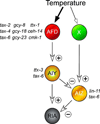Temperature sensing across species
- PMID: 17219191
- PMCID: PMC2879131
- DOI: 10.1007/s00424-006-0199-6
Temperature sensing across species
Abstract
The ability to detect changes in temperature is a fundamental sensory mechanism for every species and provides organisms with a detailed view of the environment. This review focuses on what is known of the neuronal and molecular substrates for thermosensation across species, focusing on the three robust model systems extensively used to study sensory signaling, the nematode Caenorhabditis elegans, the fruit fly Drosophila melanogaster, and the laboratory mouse. Nematodes migrate to thermal climes that are amenable to their survival, a behavior that is regulated primarily through a single sensory neuron. Additionally, nematodes "learn" to seek out this temperate zone based upon their prior experience, a robust model of learning and memory. Drosophila larvae also prefer select thermal zones that are optimal for growth and have also developed vigorous mechanisms to avoid unfavorable conditions. In mammals, the transduction mechanisms for thermosensation have been identified primarily due to the fact that naturally occurring plant products evoke distinct psychophysical sensation of temperature change. More remarkably, the elucidation of the molecular sensors in mammals, along with those in Drosophila, has demonstrated conservation in the molecular mediators of temperature sensation across diverse species.
Figures



References
-
- Mori I. Genetics of chemotaxis and thermotaxis in the nematode Caenorhabditis elegans. Annu Rev Genet. 1999;33:399–422. - PubMed
-
- Bono Md, Villu Maricq A. Neuronal substrates of complex behaviors in C. elegans. Annu Rev Neurosci. 2005;28(1):451–501. - PubMed
-
- Mori I, Ohshima Y. Neural regulation of thermotaxis in Caenorhabditis elegans. Nature. 1995;376(6538):344–348. - PubMed
Publication types
MeSH terms
Grants and funding
LinkOut - more resources
Full Text Sources
Molecular Biology Databases

